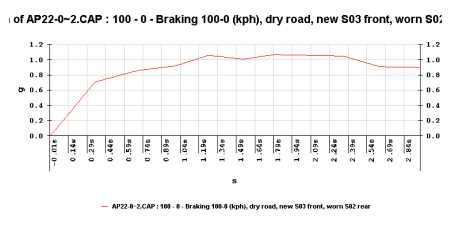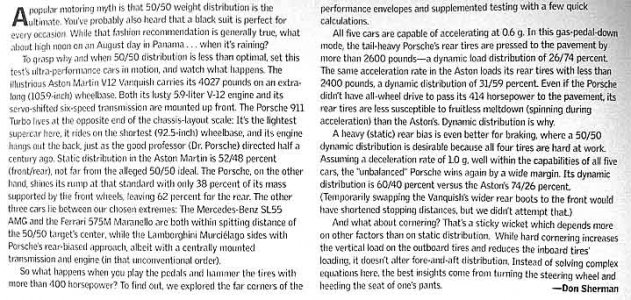Last night I went out and did some acceleration runs with the AP-22 I finally attached to the car.
I also did some brake-test from 100 kph to 0. The car tracked straight, no problem there, but I was a bit dissapointed with the results so maybe it's just the technique I'm using.
Road was dry tarmac, no too rough. Tires are new S03 in front and almost worn-out S02 in the back.
Restults were 2.96 second to stop. That is 41.1 meter from 100 kph or 126 feet from 60 mph.
What I do is that I accelerate to the point the AP22 tells me to start braking, Then I stomp on the brakepedal as hard as I can and let the car and ABS to the rest.
Should I use a different technique to do this.
I've attached a sample run below:
Start Speed 100.0kph
kph s g km
90.0 0.36 0.71 0.009
80.0 0.70 0.86 0.017
70.0 1.00 0.92 0.023
60.0 1.27 1.06 0.028
50.0 1.55 1.01 0.032
40.0 1.80 1.07 0.036
30.0 2.08 1.06 0.038
20.0 2.36 1.05 0.040
10.0 2.65 0.91 0.041
0.0 2.97 0.90 0.042
Peak G: 42.6kph 1.73s 0.035km 1.10g
I also did some brake-test from 100 kph to 0. The car tracked straight, no problem there, but I was a bit dissapointed with the results so maybe it's just the technique I'm using.
Road was dry tarmac, no too rough. Tires are new S03 in front and almost worn-out S02 in the back.
Restults were 2.96 second to stop. That is 41.1 meter from 100 kph or 126 feet from 60 mph.
What I do is that I accelerate to the point the AP22 tells me to start braking, Then I stomp on the brakepedal as hard as I can and let the car and ABS to the rest.
Should I use a different technique to do this.
I've attached a sample run below:
Start Speed 100.0kph
kph s g km
90.0 0.36 0.71 0.009
80.0 0.70 0.86 0.017
70.0 1.00 0.92 0.023
60.0 1.27 1.06 0.028
50.0 1.55 1.01 0.032
40.0 1.80 1.07 0.036
30.0 2.08 1.06 0.038
20.0 2.36 1.05 0.040
10.0 2.65 0.91 0.041
0.0 2.97 0.90 0.042
Peak G: 42.6kph 1.73s 0.035km 1.10g





